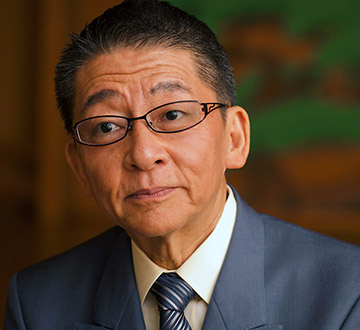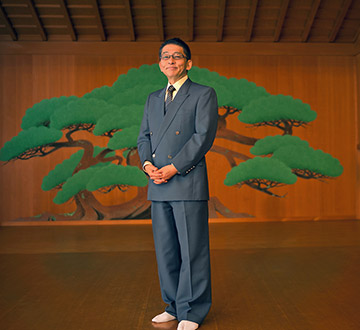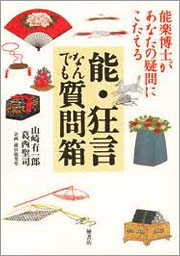 |
 |
 |
| | Home | People behind the Scenes | Seiji Kasai |
| |
|
|
![]() Part 1 : What drew you to begin working with Noh?
Part 1 : What drew you to begin working with Noh?
![]() Part 2 : Enjoying Noh. What can we learn from Noh?
Part 2 : Enjoying Noh. What can we learn from Noh?
Part 2 : Enjoying Noh. What can we learn from Noh?
Learning from various people how to enjoy Noh
The many wonderful people I met through my work with NHK and the Yokohama Noh Theatre taught me different ways of enjoying Noh. So while I couldn’t actually perform myself, I could help others enjoy Noh. I would invite children and seniors who had never seen Noh to come to a performance and would hold lectures throughout Japan to introduce people to the world of Noh and Kyōgen.
One fun part about Noh is the theatre itself. The trip to the theatre is fun. I still get really excited just stepping through the theatre doors. The Noh theatre has its own special aroma, something you don’t experience in a Kabuki theatre. The small space seems filled with the scent of wood, and being there is similar to shinrinyoku (“forest bathing,” the practice of walking through the forest as a form of aromatherapy). Particularly in private stages made of older trees, you really get the feeling of Noh.
The seats in the kenjo are also interesting. It is wonderful to look on stage from lots of different angles — from right in front, as well as from the middle and side seats. It’s much more interesting than a regular performance hall. Sitting in different seats each time allows you to discover new and interesting things, and the fascination never ceases.
I learned that what I was so bored with as a child was actually something very fun. When I asked Genshō Umewaka about falling asleep during a performance, he said “it is fine, as long as you don’t snore.” This set me at ease. It’s natural to fall asleep if something is soothing, and tough if it’s not. There is nothing more soothing to fall asleep to than a Noh performance.
I was impressed with how Yūichirō Yamazaki would fall asleep. He would somehow be asleep, yet still watching. He was truly an amazing sleeper. He would never snore, only closing his eyes and breathing peacefully. But he was listening, because when there was an important scene, he would instantly open his eyes. He was a genius at watching Noh, and I wanted to be just like him.
It was also fun watching the actors grow. I looked forward to seeing them in each of them grow up, performing different plays and meeting them on stage. I wanted them to be able to perform plays that were appropriate for their age.
It’s also fun to see how different people enjoy watching Noh. For example, I was interested in how authors on Noh and Noh critics like Nozomu Hayashi, Tatau Murakami and Tamotsu Watanabe watched Noh. I respected them so deeply for writing so profoundly about the subject, and was really excited to learn how they viewed it. I could watch a play once and enjoy it, and then read their work and enjoy it again in a different way. It was fun to have this kind of deeper understanding.
Noh is a window to life
 |
Photo: Shigeyoshi Ohi |
One thing that was impressive about the Noh actors is that they picked up the act almost immediately without any rehearsal. You don’t see that in other performing arts. Noh is a part of them from a very young age, and they are polished professionals. There is nothing about them that is amateur. Each actor’s serious approach to life is really wonderful, and is something that is greater than just entertainment. Noh is a window to life and humanity.
When you begin to understand that, you can start to enjoy the performance as an audience member in the kenjo again. You begin to really take the act of watching the play seriously. While Kyōgen is comedy, it is also much more than that.
Kabuki is similar, and because Kabuki was traditionally viewed while drinking, I think allowing alcohol in the audience is just fine. Firelight Noh and outdoor Noh are a bit more relaxed, but theatre performances are much more serious.
You get this sense the moment you step into a theatre. The sound of the rhythm and the vocals — it’s not unlike the occult, in that you can feel the spirit of famous past performers. The Noh stage is something the performers approach with focus. If you develop this same focus in watching a performance, the stage becomes a truly unforgettable experience.
The beauty of the Edo era captured in the words of famous costume makers
In addition to the famous actors, there are a number of famous mask makers and costume makers who have done a lot to support the culture of Noh. One of these is Akira Yamaguchi, head of the Yamaguchi Noh Costume Research Institute, who told me something I will never forget: “Even with today’s money, you could never recreate the costumes of the Edo era.”
The peace of the time, the quality of patronage of craft and culture and Japanese craftsmanship was amazing during the Edo era, Yamaguchi told me. The strength of the soil, mulberry production, silkworm production, and the Japanese ability to turn these into beautiful thread all reached a peak during the Edo era. It amazed me to hear that we could never hope to recreate these, even with today’s top technology.
A wide range of Japanese culture is connected to Noh. It extends to traditional Japanese craft. The long history of Noh flourished during the Edo era, and the Japanese of the time possessed not only highly refined performance, but beautiful Noh costumes.
Although they are now fading, the Noh costumes of the Edo era were dyed fantastically brightly. The quality of the soil was different, and even plant-based dyes such as those made from safflower produced vibrant colours. While the faded colours may invoke a sense of wabi-sabi, they do not truly represent traditional Japanese culture.
I can’t help but imaging how beautiful Edo-era Noh must have been performed in such elegant costumes bathed in natural light.
Providing more opportunities for children and young people
In the temple schools of the Edo era, children were taught short songs known as koutai. Through them, they learned stories, history, lessons, religious sensibilities, and polished their morals. They established the basics of living as a Japanese person, only now, that tradition has been lost.
Now parents don’t teach their children traditional stories, and they don’t learn them in school. While I am never disappointed in students in my lectures, I do give them questionnaires. Maybe two of ten will know who Ushiwakamaru and Benkei are — these things have disappeared from common knowledge.
Most cannot write out the traditional Japanese syllabary in its entirety, and only know the part of the Chinese sexagenary cycle in which they were born. We can’t be embarrassed about things children aren’t taught. It’s just not part of the educational system, and we have lost part of our Japanese identity as a result.
Noh is a living textbook and picture book
We can help to build the Japanese identity of children by having them watch Noh from a young age. This is how we can create a lasting impression, because Noh is a living textbook and picture book. Traditional Japanese music classes for children are beginning to appear lately, and it would be great for them to study the instruments of Noh as well. In that sense, children living in areas where they are able to experience traditional instruments in festivals are more in touch with their Japanese identity.
One great thing about working with NHK was being transferred to areas with a strong sense of this identity. Festivals are part of life, and they connect to both Noh and Kyōgen. In this way, the culture becomes more and more a part of you.
When I was young, since we had the Otorisama festival, I was able to enjoy Shinto music. This is why festivals are so important, and why ignoring them causes us to lose our Japanese identity. And who doesn’t like going to a festival? Since there are so many opportunities, I really want everyone to experience Japanese tradition and build their Japanese identify. I’m not a nationalist, but I do think we must do our best to preserve one of the world’s beautiful cultures.
Whenever we record a Noh performance, I always bring the junior announcers with me. I tell them they don’t have to enjoy it, just sit and watch, that it is something they should experience. I teach them that, as journalists, they must at least visit a Noh or Kabuki theatre and experience a live performance.
Noh has been preserved for a reason, and should continue to be
 |
Photo: Shigeyoshi Ohi |
Noh has been preserved because Japanese people thought it was worth preserving. If it wasn’t, it would have died out. But the tradition won’t be passed on if people don’t go to the theatre.
While I don’t want the original austerity of Noh to be disturbed in any way, I do think sharing the knowledge present in the world of Noh is important in its popularization. We need fresh ideas to remove barriers and make sure audience seats are filled. I want not only regulars, but people who have never seen a performance to leave having enjoyed themselves.
Japanese traditional arts require explanation and guidance. As a supporter of Noh, I want to share ways of enjoying Noh and experiencing the theatre that don’t discourage its appreciation. My dream is to continue to share the world of Noh with as many people as possible.
Interview: September 2011
Profile : Seiji Kasai (Announcer / Commentator on Japanese Classical Performing Arts)
Born in Tokyo, Seiji Kasai graduated from the law department of Chuo University. He has appeared on numerous television and radio shows as an executive announcer with NHK. He now uses that experience to lecture on Kabuki and other classical arts, give talks on traditional Japanese culture at universities, run recital classes, and to write. He is a Japan Theatre Arts Association member, NHK Culture Center instructor, Chuo University public lecturer, and part-time lecturer at Nippon Sport Science University, Yamanashi Eiwa College, and Beppu University. He has authored Bunraku No Tsubo (A Treasure Chest of Words), Mei Serifu No Chikara — Nihongo O Kitaeru 76 No Kotoba, (The Power of Famous Lines — 76 Phrases to Improve Your Japanese), Kotoba No Kissaki (The Cutting Edge of Words), and co-authored many works including Noh No Takumi-Tachi (The Masters of Noh), Nohgakushi Jikenbo (A History of Noh), Noh Kyōgen Nandemo Shitsumon Bako (Noh and Kyōgen Q&A) and Migoto Na Shi (A Beautiful Death).
| Terms of Use | Contact Us | Link to us |
Copyright©
2025
the-NOH.com All right reserved.

